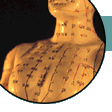Dryness
Dryness is the main pathogenic factor in autumn. Its characteristics
are as follows:
Pathogenic dryness is apt to consume yin, especially body fluids
Clinical manifestations are dryness of the mouth, lips and nose, dryness of the tongue, dry, rough and chapped skin, dry stool, etc.
Pathogenic dryness is liable to injure the lung
The lung is considered a tender organ which prefers moisture, cleanliness, and descent. If pathogenic dryness attacks the body from the mouth and nose, the yin fluid of the lung is likely to be consumed. It may lead to the dysfunction of dispersion and descent, and manifest as dry cough with scanty sputum, sticky mucus causing difficult expectoration, or bloody sputum, etc.
Commonly seen syndromes caused by pathogenic dryness are cool dryness and warm dryness.
Main clinical manifestations of cool dryness: fever, aversion to cold, headache, no sweating, dryness of the mouth and nose, dry skin, cough with scanty or no sputum, dry white and thin tongue coating.
The symptoms of cool dryness are similar to symptoms caused by exogenous pathogenic cold, but are accompanied with the symptoms of body fluid insufficiency.
Main clinical manifestations of warm dryness: fever, mild aversion to wind and cold, headache, scanty perspiration, dry cough, or cough with a small amount of sticky sputum, dry skin, thirst, irritability, red tongue tip and sides, and dry scanty tongue coating. The warm dryness syndrome is similar to the mild heat syndrome, indicating that the body fluid is exhausted.
More about the other Exogenous Factors:
Wind,
Cold,
Summer-heat,
Damp,
Fire Heat and Mild Heat.
| 
 This website is published, edited and designed by Raymond Cheng,
and reflects only and only his personal views and opinions in his individual capacity.
The information available at this website is not intended
directly or by implication to either diagnose or treat any
medical, emotional, or psychological condition or disorder.
It is also not intended to create a physician-patient relationship
between you and I or between you and Wyith Institute™ and The Office of Dr Raymond K K Cheng.
The information here is not a substitute for advice and treatment provided
by your physician or by another healthcare professional.
It is always recommended that consultation with local healthcare providers
be obtained for any of your specific health or medical concerns.
Furthermore, any products that can be purchased (yet you can see I don't have much
to sell here) through advertisers' banners or through links to other websites
are not either explicitly or implicitly given any warranty or endorsement
by me, my colleagues, Wyith Institute™ or any of its associated businesses.
This website is published, edited and designed by Raymond Cheng,
and reflects only and only his personal views and opinions in his individual capacity.
The information available at this website is not intended
directly or by implication to either diagnose or treat any
medical, emotional, or psychological condition or disorder.
It is also not intended to create a physician-patient relationship
between you and I or between you and Wyith Institute™ and The Office of Dr Raymond K K Cheng.
The information here is not a substitute for advice and treatment provided
by your physician or by another healthcare professional.
It is always recommended that consultation with local healthcare providers
be obtained for any of your specific health or medical concerns.
Furthermore, any products that can be purchased (yet you can see I don't have much
to sell here) through advertisers' banners or through links to other websites
are not either explicitly or implicitly given any warranty or endorsement
by me, my colleagues, Wyith Institute™ or any of its associated businesses.



 Thank you for visiting this TCM and acupuncture information website.
If you have previously been to this website, you might have
noticed that some of the pages on ancient historical ideas and
holistic thinkings related to Chinese metaphysics are temporarily taken offline.
This is because I will be revamping the whole website and be moving
those information into a new \"Ancient Chinese Culture\" section
so as to reflect a more current perspective on the interpretation
of some of the fundamental concepts as well as to include
some of the latest information in the area.
But if you have just found this website for the very first time, I welcome you again and
wish you could find what you require and, hopefully, you could also be benefitted
from reading the articles I published on this website.
Thank you for visiting this TCM and acupuncture information website.
If you have previously been to this website, you might have
noticed that some of the pages on ancient historical ideas and
holistic thinkings related to Chinese metaphysics are temporarily taken offline.
This is because I will be revamping the whole website and be moving
those information into a new \"Ancient Chinese Culture\" section
so as to reflect a more current perspective on the interpretation
of some of the fundamental concepts as well as to include
some of the latest information in the area.
But if you have just found this website for the very first time, I welcome you again and
wish you could find what you require and, hopefully, you could also be benefitted
from reading the articles I published on this website.